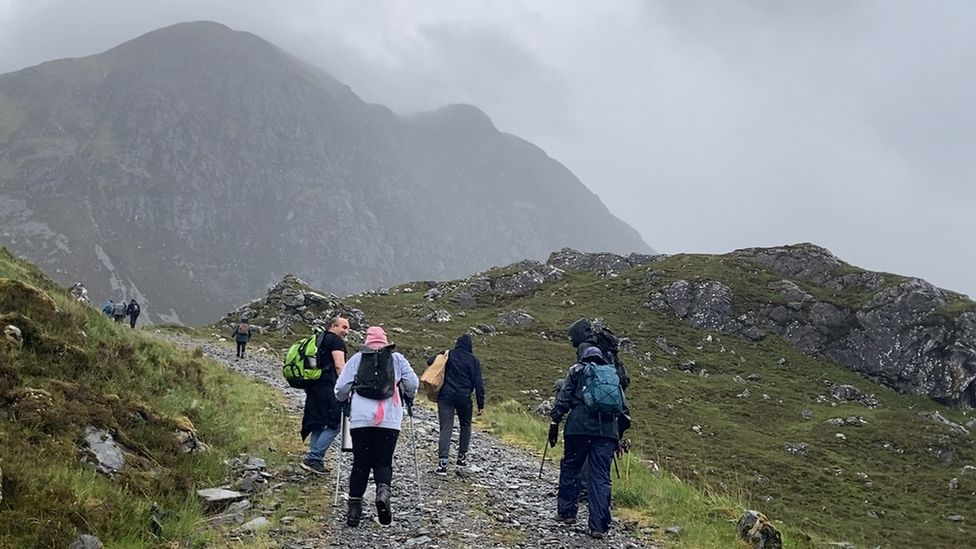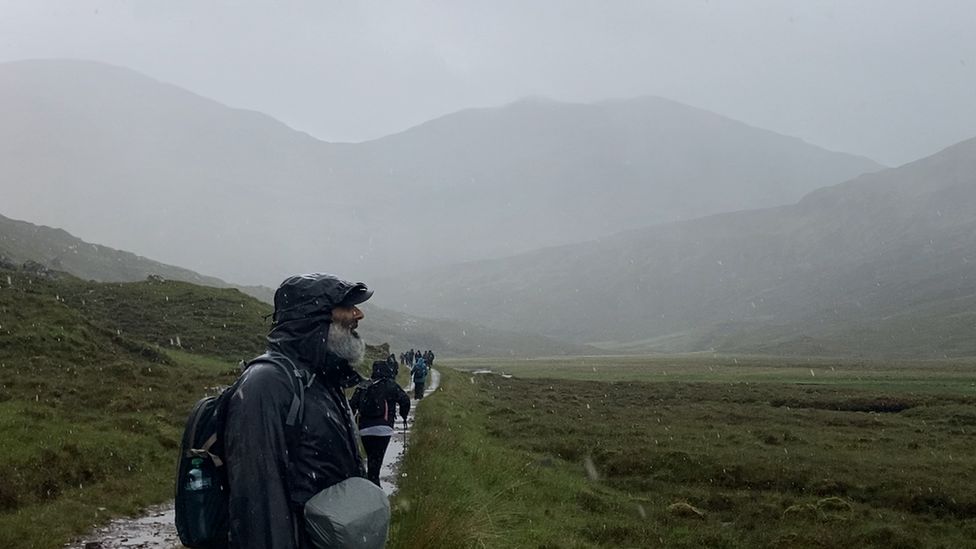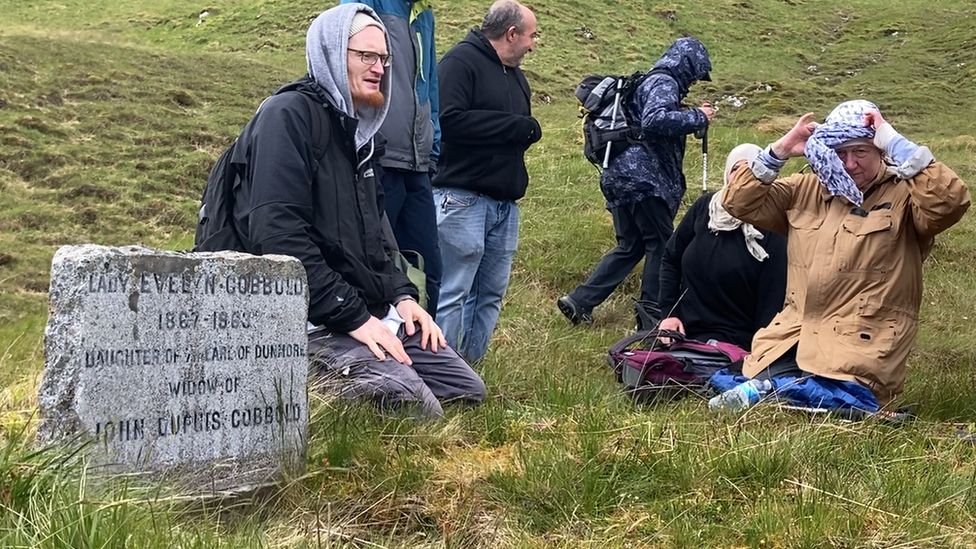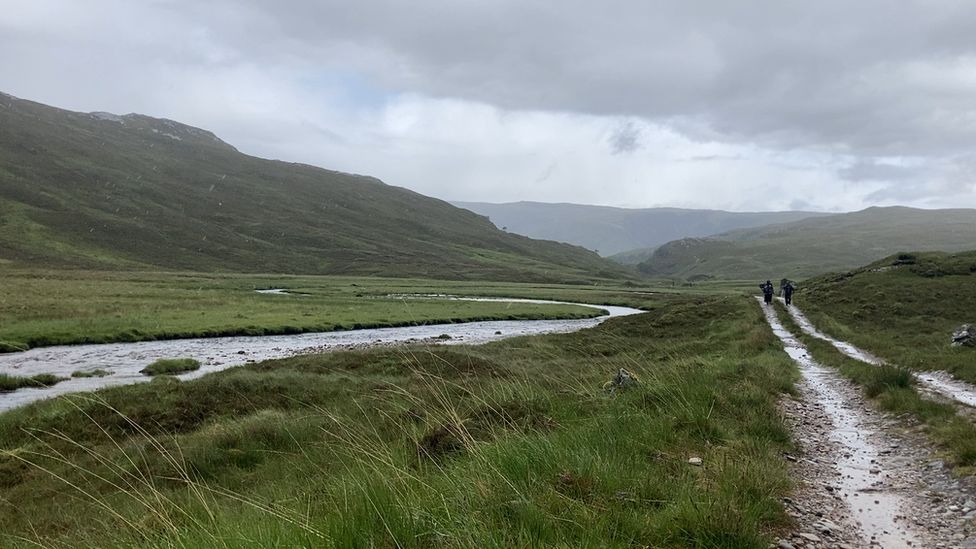



A group of about 20 Muslims took part in the walk to Lady Evelyn's grave
The day promises to be wet, but there's a brief moment of sunshine as a group of 20 walkers prepare for a 10km (6.2 mile) walk up Gleann Fhiodhaig in Wester Ross.
It's a scene played out in hundreds of car parks across Scotland every weekend, but this group of walkers are also pilgrims - Muslim converts who plan to visit the grave of a Victorian aristocrat.
They've travelled from Edinburgh, Liverpool, Leicester and beyond to honour Lady Evelyn Cobbold - thought to be the first British-born Muslim woman to make the Hajj pilgrimage to Mecca.
The religious celebration was organised by The Convert Muslim Foundation, a UK-based charity which provides support networks for people new to Islam.
Founder Batool Al-Toma, herself a convert from Ireland, beckons the group to begin their journey into the mountains.
"Ever since I heard about Lady Evelyn, I've been interested in her story. She was quite a formidable lady who never let herself be sidelined just because she was a woman," Ms Al-Toma says.

This area of Scotland has a unique connection to Mecca through Lady Evelyn
Not long into the walk, the rain starts. Hats and waterproof hoods cover heads and hijabs.
As the wind and rain batters them, many of the group ponder Lady Evelyn's final journey up the glen to her chosen burial spot.
She died in January 1963 during a particularly cold winter and was buried on an isolated hillside on her Glencarron estate.
A lone bagpiper, "shaking from cold", played MacCrimmon's Lament and an Imam from Woking, Surrey, performed the burial rites, according to an account published on the Inverness Mosque website.
The link to Woking still exists, with a representative from the town's mosque joining this walk to her grave almost 60 years later.

Lady Evelyn married John Cobbold in 1891 after she met him while travelling in Cairo
Born in Edinburgh in the late 1800s, Lady Evelyn spent her childhood split between Scotland and North Africa.
It was during her time there that she was first exposed to Islam, visiting mosques with her Algerian friends.
"Unconsciously I was a little Muslim at heart," she later wrote.
Lady Evelyn took the Arabic name Zainab and would eventually make the Hajj pilgrimage to Mecca aged 65.
One of the Muslim converts paying tribute to Lady Zainab is Yvonne Ridley, who lives in the Scottish Borders.
It was her experience of working as a journalist in Afghanistan and being captured by the Taliban in 2001 which led to her embracing Islam.
"My conversion was triggered in many ways by my arrest and detention at the hands of the Taliban. That experience set me on a path which started out as an academic exercise but took me on a spiritual journey," she says.
In her book, In the Hands of the Taliban, Ms Ridley said she was amazed by the respect and courtesy the men of the Taliban had shown her.
During her captivity she promised to study the Quran and did so after she was released.
Ms Ridley learned about Lady Evelyn from Ms Al-Toma while they were in Turkey.
"I started reading more about this remarkable Scottish woman, so Batool and I decided we would get a group of converts to Islam and come out and make a pilgrimage to her graveside," she says.

The group gathered at the graveside for prayers
After three hours of cold, wet hiking, the pilgrims rest for a moment as their guide Ismail Hewitt, clad in his kilt, goes further on ahead to look for Lady Evelyn's resting place.
Spirits are lifted as he waves back from the distance, signalling that it's in sight, a short way up the hill.
The group walk up to it before gathering around the tombstone on their knees.
They each pay their respects before joining each other in prayer. It is a moving moment and a few of the group are brought to tears.
Ms Al-Toma finishes off the ceremony by reading an excerpt from Lady Evelyn's book, reflecting on her pilgrimage to Mecca.
"What have the past days held out but endless interest, wonder and beauty? To me an amazing new world has been revealed."

The pilgrims made a 20km (12.4 mile) round trip to visit the grave
After the trek back to the road, the travellers were invited to the mosque in Inverness for food and a chance to reflect on the journey they had made.
Ms Ridley says she was exhausted by the walk, but felt the prayers by the grave had been "spiritually moving".
"There was a stag which appeared on the hill above her graveside which was quite symbolic and moving," she says.
"This was a woman whose heart was in the Highlands, but was also very immersed in Islam."
Ms Al-Toma agrees that Lady Evelyn was a model of how new converts could still hold onto their own identity and culture.
"She is very important to converts here," she adds.
"I'm happy to have read her book and made this walk as I admire her courage, bravery and sense of adventure. She was a real trailblazer."
-- Courtesy of BBC News